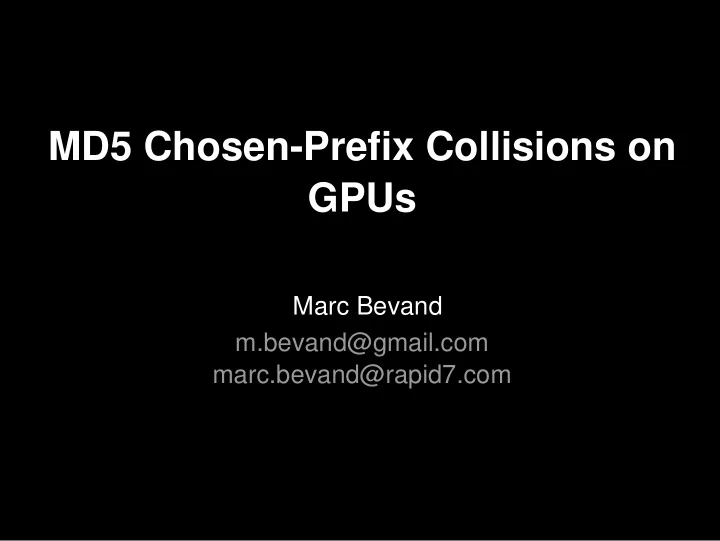

MD5 Chosen-Prefix Collisions on GPUs Marc Bevand m.bevand@gmail.com marc.bevand@rapid7.com
Agenda MD5 on GPUs Dec 2008: rogue CA certificate on PS3 cluster MD5 birthday search Results & performance
MD5 on GPUs MD5 is optimized for 32-bit architectures 32-bit integer & logical instructions GPGPU tech makes it possible to run arbitrary code GPUs are massively parallel chips with lots of ALUs
MD5 on GPUs (cont'd) Let me repeat: ”massively parallel” As in hundreds of instructions per clock Why isn't everybody doing GPGPU ?! Lack of awareness
Why ATI GPUs (cont'd) ATI R700 GPU family (Radeon HD 4000 series): Up to 800 Stream Processing Units per ASIC Clocked up to 850 Mhz Dual-GPU video cards Best perf/W and perf/$ (May 2009): HD 4850 X2 2 nd fastest video card in the world 1 trillion 32-bit instructions/sec (2 TFLOPS) TDP 230W, Price US$250 Can't wait to see next-gen R800
Why not Nvidia Top-of-the-line member of the Nvidia GT200 GPU family: GTX 295 596 billion 32-bit instructions/sec TDP 290W, Price US$500 Raw perf/W and perf/$ respectively roughly 2 times and 4 times worse than HD 4850 X2 However Nvidia CUDA SDK is more mature Next-gen GT300 will be better ?
Rogue CA When: Dec 2008, paper published in Mar 2009 Where: 25 th Chaos Communication Congress (25C3) Who: 7 researchers (Sotirov, Stevens, Applebaum, Lenstra, Molnar, Osvik, Weger) What: implemented an MD5 chosen-prefix collision attack on a cluster of 215 PlayStation 3s to create a rogue CA
Rogue CA (cont'd) Simplified explanation: Create cert ”A” and rogue CA cert ”B” with same MD5 hash Get a CA to sign a cert signing request that end up producing cert A Steal A's signature and apply it to B How to generate A and B with same MD5 hash: ”Birthdaying” stage ← most computing intensive part ”Near collision” stage
MD5 ”Birthdaying” We have 2 ”chosen-prefix” bitstrings (certs) When processed through MD5, lead to 2 different MD5 states (8 32-bit variables): A, B, C, D A', B', C', D' Goal of birthdaying is to append a small number of bits to find a state such as the 8 variables satisfy some conditions (see Mar 2009 paper)
MD5 ”Birthdaying” (cont'd) Technique to find these conditions: deterministic pseudo-random walk in search space using Pollard- Rho method Same concept as a rainbow table chain ”walking” through the search space except we are looking for collisions ! Basically this search consists of running the MD5 compression function over and over [TODO: schema]
MD5 CAL IL Implementation Therefore to optimize the attack, a fast MD5 implementation had to be developed Hand-coded one in CAL IL (Compute Abstract Layer Intermediary Language) – a pseudo-assembly language for ATI GPUs
MD5 in CAL IL ”CAL IL”: looks as bad as it sounds :)
Performance 1634 Mhash/sec on HD 4850 X2 (1.6 billion MD5 compression function calls per second) – IOW MD5 processes 105 GByte/s Possible future optimization: due to a particularity of the birthday search, the first 14 out of 64 steps of the compression function can be pre-computed – should allow 2090 Mhash/sec
Theoretical GPGPU cracking server 4 Radeon HD 4850 X2 in a single machine 8 GPUs total About US$1500 Power draw: 950 W from the wall Total of 6536 Mhash/s
Here it is
HW Implementation Details QEMU/KVM PCI passthrough feature to work around ATI's fglrx.ko driver limitation of 4 GPUs Flexible cut-out PCI-Express extenders to down- plug x16 cards on cheap motherboards with x1 slots Undocumented secret: short pins A1 & B17 to work around down- plugging compatibility issues
Comparison with PS3 cluster 215 PS3s: 28 kW (130 W each) US$86k (US$400 each) 37600 Mhash/s (175 Mhash/s each) 6 GPGPU servers: 5.7 kW (950 W each) – 5 times less power US$9k (US$1500 each) – 10 times cheaper 39200 Mhash/s (6536 Mhash/s each) – and a bit faster
Conclusion Another blow to MD5 – chosen-prefix collision attack now practical for anybody Public CAs have stopped signing with MD5 – what about private/corporate CAs ? If a workload can run on GPUs, do it. They are a commodity and so efficient that considering anything else does not make sense. Code & tools will be open-sourced on the project page: [TBD]
Recommend
More recommend